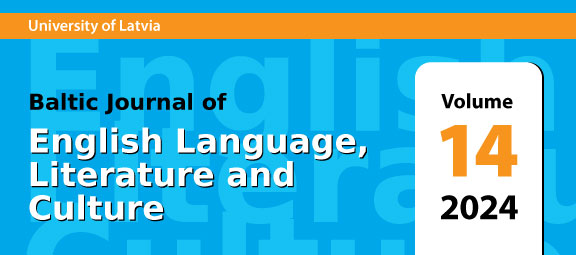A Virtual Exchange to Boost Students’ Intercultural Communication Skills in English
DOI:
https://doi.org/10.22364/BJELLC.14.2024.02Keywords:
intercultural communication, virtual exchange, English communication skills, ICT in education, motivationAbstract
How can universities enhance their students’ internationalisation at home? The need to find teaching methodologies that boost students’ intercultural communication skills without travelling abroad has motivated the present study, carried out by two English lecturers from Florida Universitaria in Spain and Jade University of Applied Sciences in Germany. Research was divided into two stages: first, a deep analysis of the intercultural experiences organised in the past at both universities; and second, the implementation of virtual encounters with students from different cultures as tools to promote interculturality at the home university. This paper aims at showing the impact of those exchanges on boosting students’ intercultural communication in English. Two groups of undergraduate students, during their English classes, worked synchronously on topics related to essential aspects of intercultural communication. The main teaching objectives of the Virtual Intercultural Communication (VIC) exchange were to increase participants’ motivation for knowing other cultures, to raise their intercultural awareness, to foster their capacity to change perspectives, and to improve students’ English language skills and their digital abilities. Through the outcomes achieved, students’ self-reported feedback, and lecturers’ observation, it can be concluded that virtual exchanges are effective tools to improve students’ intercultural communication while they meet the English learning objectives.
References
Allen, T. J. (2021) Exploring students’ perceptions about intercultural communication education: rethinking the design and facilitation of a course in Japan. Intercultural Communication Education, 4 (3): 213-233. Available from https://doi.org/10.29140/ice.v4n3.475 [Accessed on 10 November 2022]. DOI: https://doi.org/10.29140/ice.v4n3.475
Avgousti, M. I. (2018) Intercultural communicative competence and online exchanges: a systematic review. Computer Assisted Language Learning, 31 (8): 819-853. Available from https://doi.org/10.1080/09588221.2018.1455713 [Accessed on 17 September 2022]. DOI: https://doi.org/10.1080/09588221.2018.1455713
Babaii, E. (2018) Multiculturalism: an asset or a problem? Implications for intercultural education. Intercultural Communication Education, 1 (2): 45-53. Available from https://dx.doi.org/10.29140/ice.v1n2.65 [Accessed on 3 November 2022]. DOI: https://doi.org/10.29140/ice.v1n2.65
Barros García, B. and Kharnásova, G. M. (2012) La interculturalidad como macrocompetencia en la enseñanza de lenguas extranjeras: revisión bibliográfica y conceptual [Interculturality as macrocompetence in foreign languages teaching: bibliographic and conceptual review]. Porta Linguarum Revista Universitaria de Didáctica de las Lenguas Extranjeras, 18: 97-114. Available from https://doi.org/10.30827/digibug.23242 [Accessed on 24 March 2023]. DOI: https://doi.org/10.30827/Digibug.23242
Cetinavci, U. R. (2012) Intercultural communicative competence in ELT. Procedia: Social and Behavioral Sciences, 46: 3445-3449. Available from https://doi.org/10.1016/j.sbspro.2012.06.082 [Accessed on 7 September 2022]. DOI: https://doi.org/10.1016/j.sbspro.2012.06.082
Chen, G. (2014) Intercultural communication competence: summary of 30-year research and directions for future study. In X. Xiaodong Dai, X. and G. Chen (eds.) Intercultural Communication Competence: conceptualization and its development in cultural contexts and interactions (pp. 14-40). Newcastle: Cambridge Scholars Publishing.
Eisenchlas, S. and Trevaskes, S. (2007) Developing intercultural communication skills through intergroup interaction. Intercultural Education, 18 (5): 413-425. Available from http://dx.doi.org/10.1080/14675980701685271 [Accessed 10 July 2021]. DOI: https://doi.org/10.1080/14675980701685271
Fetcher, D. (2010) Virtual classrooms. In A. Weidemann, J. Straub and S. Nothnagel (eds.) Wie lehrt man interkulturelle Kompetenz? [How can intercultural competence be taught?] (pp. 417-432). Bielefeld: Transcript Verlag. DOI: https://doi.org/10.1515/9783839411506-019
Holliday, A. (2018) Designing a course in intercultural education. Intercultural Communication Education, 1 (1): 4-11. Available from https://dx.doi.org/10.29140/ice.v1n1.24 [Accessed on 3 October 2022]. DOI: https://doi.org/10.29140/ice.v1n1.24
Implementation Guidelines: Erasmus+ and European Solidarity Corps Inclusion and Diversity Strategy (2021) Available from https://erasmus-plus.ec.europa.eu/document/implementation-guidelines-erasmus-and-european-solidarity-corps-inclusion-and-diversity-strategy [Accessed on 13 June 2023].
Schumann, A. (2012) Critical incidents als Forschungsinstrument und als Trainingsgrundlage [Critical incidents as research tool and as a basis for training]. In A. Schumann (ed.) Interkulturelle Kommunikation in der Hochschule [Intercultural Comunication at College] (pp. 55-79). Bielefeld: Transcript Verlag. DOI: https://doi.org/10.1515/transcript.9783839419250.55
Spitzer, B. H. (1997) A model of intercultural communication competence. In L. A. Samovar and R. E. Porter (eds.) Intercultural Communication: a reader (pp. 375-387). Belmont: Wadsworth Publishing.
Svenkerud, J. A. and Källström, E. (2012) Collaborative learning in multicultural settings. Advances in Higher Education, 1 (4): 7-33.
The European Commission (2023). The Erasmus+ Programme Guide. Available from https://erasmus-plus.ec.europa.eu/node/4199 [Accessed on 22 May 2023].
Varmer, I. and Beamer, L. (2011) Intercultural Communication in the Global Workplace. New York: McGraw-Hill.
Williams, K. and Williams, C. (2011) Five key ingredients for improving student motivation. Research in Higher Education, 12 August: 104-122. Available from http://scholarworks.csustan.edu/handle/011235813/645 [Accessed on 20 September 2010].
INTERNET SOURCES
[Online 1] Available from https://www.daad.de/de/der-daad/was-wir-tun/fortbildung-expertise-und-beratung/datenerhebung-von-studienbezogenen-auslandsaufenthalten/auslandsmobilitaet-zielquoten-und-formen/ [Accessed on 12 January 2023].
[Online 2] Available from https://www.bertelsmann-stiftung.de/fileadmin/files/BSt/Presse/imported/downloads/xcms_bst_dms_30238_30239_2.pdf [Accessed on 2 January 2023].
[Online 3] Available from https://www.fondazionecariplo.it/it/index.html [Accessed on 2 January 2023].
[Online 4] Available from https://www.uni-kassel.de/mumis/www.mumis-projekt.de/mumis/index.php/critical-incidents.html [Accessed on 2 June 2023].
Downloads
Published
How to Cite
Issue
Section
License
Copyright (c) 2024 University of Latvia

This work is licensed under a Creative Commons Attribution-NonCommercial 4.0 International License.


